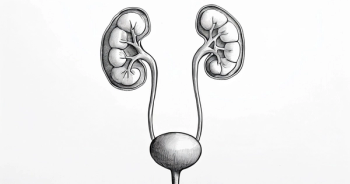
Participants Discuss ctDNA and NGS in Muscle-Invasive Bladder Cancer
During a live event, participating oncologists discuss the role of ctDNA and molecular testing in muscle-invasive bladder cancer.
DISCUSSION QUESTIONS
- What is your approach to post-operative management of an older patient with stage III muscle-invasive bladder cancer with medical comorbidities?
- For your patients with high-grade bladder cancer, do you routinely obtain a tissue next-generation sequencing (NGS) molecular assay and/or test for urinary biomarkers at diagnosis?
Sumanta K. Pal, MD: If you were going to think about genetic testing or molecular testing in a patient such as this, do you typically do that in this specific context for a patient with muscle-invasive disease? If you see a patient like this who has muscle-invasive bladder cancer, would you always order NGS and PD-L1 staining, or is it more of a judgment call based on certain circumstances?
Ashish D. Dwary, MD: No, I don’t order it all the time. It’s just based on the circumstances.
Esther G. Chong, MD: I don’t usually get an NGS in this particular setting, because it wouldn’t change my management in [an older patient as described].
Pal: That’s a very reasonable point…. Let’s say a patient had T2 disease but didn’t have lymph node involvement. Would that change your perspective? Would you still offer adjuvant therapy in that setting, even without nodal positivity?
Sharmeen Mahmood, MD: I would [if] the patient is pretty debilitated, and I would hesitate to use chemotherapy in such patients.
Pal: I tend to agree. I think it was much more challenging in the era of chemotherapy because the data we had were based on incomplete phase 3 clinical trials. We never pulled off a successful adjuvant chemotherapy trial in patients with muscle-invasive disease. They all fell short of expectations. I think part of the rationale for that is investigators had a lot of bias heading into these trials. They had a perspective on who should and who shouldn’t get adjuvant therapy, so these studies failed to accrue [patients]. It’s nice that now we have these placebo-controlled efforts. They give us some sense of what to do in this scenario.
I know a lot of you see a lot of patients with lung cancer, so in a scenario like this, would you consider doing any sort of circulating tumor DNA [ctDNA] assay or any other element that would help inform your decision-making here?
Xinting Fu, MD: No, I’m not familiar with ctDNA testing and how reliable that is in terms of directing treatment. I’m eager to learn more, but it’s not one of my standard practices.
Pal: I agree with you. I don’t tend to do ctDNA testing in this setting. There’s an impressive paper in the Journal of Clinical Oncology from a couple of years ago that looks at the Signatera test in the context of muscle-invasive disease.1 It uses genetic features at baseline and then scouts for those genetic features in the blood distally, and it will tell you about the presence or absence of residual disease.
I think my colleagues who specialize in bladder cancer are split on this. I have some who order it routinely in the course of this adjuvant setting, and I have others who are a bit more hit-or-miss or cautious around doing it. In a situation like this, the problem is…we don’t have a lot of data, in my opinion, that would guide whether or not a ctDNA assay would be useful in prescribing or not prescribing an adjuvant treatment.
There’s a phase 3 study underway right now, primarily in Europe, called IMvigor011 [NCT04660344], and that study is using ctDNA characteristics. If [the patient’s disease is] ctDNA negative, where there’s probably not a very high chance of recurrence, they get observation, and if they’re ctDNA positive, they’re randomly assigned to get immunotherapy or not, to see if the investigators can tease out a subpopulation that really needs treatment. But until we have data like that, I think using ctDNA is not going to be particularly popular.
William E. Lee, MD: The purpose of the Signatera test is to help document whether or not there’s early recurrence, more than dictating adjuvant therapy. I order Signatera for patients primarily for that reason—to see if I can detect recurrence sooner than the scans, for example. Now, whether I do anything about that or not, isn’t that the role of Signatera for bladder cancer?
Pal: The most powerful role is going to be if it has a predictive role for immunotherapy. If those trials looking at prospective allocation of adjuvant treatment are positive, that’s going to be a huge win because then we could use it to say this patient needs adjuvant therapy, and this patient does not.
At least in the context of the drugs they’re looking at right now…let’s say you do a Signatera test and stagger it in between your CT scans every 3 months for a patient—there might be circumstances where you do beat the scan in detecting metastatic disease. But from what I’ve seen in addressing patients myself and with colleagues, those circumstances are few and far between. I haven’t seen huge value in that. But have you had experiences where you’re detecting disease well ahead of scan-based recurrence?
Lee: It’s usually when the scans are every 6 months to a year, and the patient would rather use the blood test instead of going through another scan. You’re right, I see the signal. I’m not quite sure I know what to do with it, but when I do see the signal, I don’t wait 6 months. I go ahead and scan immediately.
Pal: That’s fair. It’s tough because it’s not a particularly evidence-based strategy in the sense that I don’t know if we necessarily know yet if Signatera can replace scans.
Signatera is a bespoke assay, so you have the dozen-plus genes that you’re selecting from the tumor at baseline. They’re not necessarily pathogenic genes; these are genes that are good markers for the cancer that you’re looking for in ctDNA subsequently. But there are other bespoke assays coming out that are going to maybe look for a hundred or, in some cases, several hundred alterations in baseline tissue and scout for ctDNA afterwards. That might be too sensitive in the sense that you might be picking up what is non-meaningful minimal residual disease in that case. But I still think that right now, substituting Signatera for scans is a little tricky, although if you have a patient who absolutely refuses to come in at regular intervals for imaging, I tend to agree that Signatera is better than nothing.
Spencer Shao, MD: Let’s say that ctDNA did predict recurrence sooner than the CT scan. Do we know that just by obtaining the ctDNA, we improve the outcome?
Pal: That’s precisely it. I don’t think we know that, from defining that early recurrence, we’re ultimately leading to a superior outcome for the patient long term. That’s why I tend to only do this in the context of studies.
There’s a very important trial [NCT05987241]that’s opening relatively soon through the Alliance for Clinical Trials in Oncology committee, and this study is going to look at allocation of adjuvant nivolumab [Opdivo] based on ctDNA. It’s not necessarily going to give the patients with ctDNA-negative disease nothing, but the ctDNA-positive population can be randomly assigned to receive nivolumab or nivolumab plus relatlimab [Opdualag], which you may be familiar with from the melanoma setting.
I think the ctDNA tests that we’re using for minimal residual disease are ultimately going to be most useful if we can use them in the context of either de-escalating or escalating therapy. But that’s part of the reason why I haven’t gotten into the habit of using it as a substitute for scans.






































